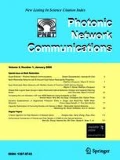Abstract
The issue of wavelength assignment is one of the most important factors that affect the capacity for the deployment of optical networks. This issue becomes more critical for multicast connections, especially when the network nodes have no wavelength conversion capability. Although the wavelength assignment can be more flexible if each node can perform wavelength conversion, the deployment cost increases accordingly. A compromise is to support a limited portion of conversion nodes in the WDM network. We propose a systematic approach for the wavelength assignment of multicast connections in WDM networks with sparse wavelength conversion nodes. The efficiency of the arrangement of wavelength is measured by its influences on the available capacity of the network and the consumption of wavelengths. By using the proposed approach, the Static Cost Greedy (SCG) algorithm [8] can be easily extended to be applicable in a Sparse Wavelength Conversion Network (SWCN). In addition, instead of SCG, the Minimum-Effect-First (MEF) algorithm is proposed to maximize the network capacity during wavelength assignment. We compare the performance of the proposed MEF methods with the extended SCG scheme through exhaustive simulations. The experimental results indicate that the proposed MEF schemes demonstrate much better performance than the SCG scheme. We also found that the performance is not always improved proportionally to the increment of the wavelength conversion nodes. The improvement reaches saturation when the number of conversion nodes is above 35% of the total number of nodes.
Similar content being viewed by others
References
Mukherjee B. (2000). WDM optical networks: progress and challenges. IEEE J. Sel. Area. Commun. 18(10): 1810–1824
Chlamtac I., Ganz A. and Karmi G. (1992). Lightpath communications: a novel approach to high bandwidth optical WANs. IEEE Trans. Commun. 40(7): 1171–1182
Sahasrabuddhe L.H. and Mukherjee B. (1999). Light-trees: optical multicasting for improved performance in wavelength-routed networks. IEEE Commun. Mag. 37(2): 67–73
Subramania S. and Barry R. (1997). Wavelength assignment in fixed routing WDM networks. Proc. IEEE Int. Conf. Commun. 1: 406–410
Strand J., Doverspike R. and Li G. (2001). Importance of wavelength conversion in an optical network. Opt. Netw. Mag. 2(3): 33–44
Subramaniam S., Azizoglu M. and Somani A.K. (1996). All-optical networks with sparse wavelength conversion. IEEE/ACM Trans. Netw. 4(4): 544–557
Li B., Chu X.W. and Sohraby K. (2003). Routing and wavelength assignment vs wavelength converter placement in all-optical networks. IEEE Commun. Mag. 41(8): S22–S28
Wang J. and Chen B. (2003). Dynamic wavelength assignment for multicast in all-optical WDM networks to maximize the network capacity. IEEE J. Sel. Area. Commun. 21(8): 1274–1284
Zhu K., Zang H. and Mukherjee B. (2003). A Comprehensive study on next-generation optical grooming switches. IEEE J. Sel. Area. Commun. 21(7): 1173–1186
Zhu Y., Rouskas G.N. and Perros H.G. (2000). A comparison of allocation policies in wavelength routing networks. Photon Netw. Comm. J. 2(3): 265–293
Chen B. and Wang J. (2002). Efficient routing and wavelength assignment for multicast in WDM networks. IEEE J. Sel. Area. Commun. 20(1): 97–109
Jia X., Du D., Hu X., Lee M. and Gu J. (2001). Optimization of wavelength assignment for QoS multicast in WDM networks. IEEE Trans. Commun. 49(2): 341–350
Jia X., Hu X., Ruan L. and Sun J. (2002). Multicast routing, load balancing, and wavelength assignment on tree of rings. IEEE Commun. Lett. 6(2): 79–81
Poo G.-S. and Zhou Y. (2006). A new multicast wavelength assignment algorithm in wavelength-routed WDM networks. IEEE J. Sel. Area. Commun. 24(4): 2–12
Zhou, Y., Poo, G.-S.: Multicast Wavelength Assignment for Sparse Wavelength Conversion in WDM Networks, Proceedings of IEEE INFOCOM, Barcelona, Spain, pp. 1–10 (2006)
Author information
Authors and Affiliations
Corresponding author
Rights and permissions
About this article
Cite this article
Chen, YW., Peng, IH. Study of multicast wavelength arrangement for maximizing network capacity in WDM networks with sparse wavelength converters. Photon Netw Commun 15, 141–152 (2008). https://doi.org/10.1007/s11107-007-0098-6
Received:
Accepted:
Published:
Issue Date:
DOI: https://doi.org/10.1007/s11107-007-0098-6




